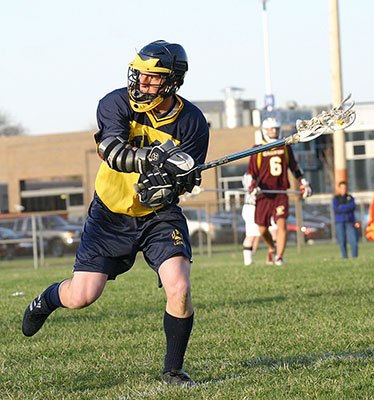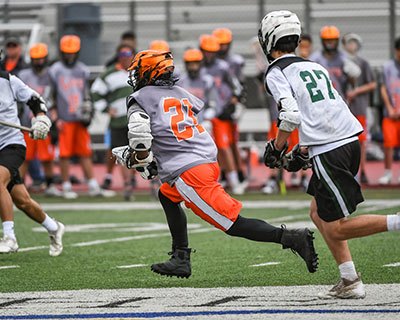Being familiar with the key penalties in lacrosse is essential, especially if you want to perfect your game. One of the most common infractions called on players is tripping—but what exactly does this penalty mean, and why should you be careful to avoid it?
In this blog post, we will provide an in-depth explanation of tripping and its consequences in lacrosse. Read on to learn everything there is to know about tripping!
More...
Take away key points:
When you want to know more about tripping in lacrosse, its punishment, and whether you can trip your opponent, refer to the guidelines below for a better understanding.
What is a tripping penalty in lacrosse?
Lacrosse is a fast-paced sport with physical contact, similar to football and hockey. But, some forms of contact are forbidden due to the risk of injuries.
Tripping in lacrosse is a harsher form of physical contact, resulting in severe punishments for violating lacrosse rules.
When is tripping not a foul in lacrosse?

There are specific lacrosse actions when they are not deemed as fouls, even if a player trips the opponent from the other team. For instance, if a player legally checks another player's stick, and during the cross-checking process, the opposing player trips over his stick and falls, there will not be a penalty called.
In addition, when the two players are chasing a loose ball, and one player tries to scoop the ground ball with his stick, the other player might accidentally trip over the opponent's stick. The referee will not call upon illegal tripping.
How does a player commit a tripping penalty?
Tripping is a personal violation of lacrosse rules defined as when a player uses their lacrosse stick or body to trip the opponent from the opposing team on the lacrosse field.
The tripping must occur below the waist, including any obstruction of the opposing team with the feet, legs, hands, arms, or stick. An opposing player commits a primary or a secondary tripping action against the other team.
Primary tripping takes place when the tripping player is on their feet, while secondary occurs when the tripping player is not on their feet. Instead, he presents an obstacle to the player who is being tripped.
Are tripping penalties technical fouls or personal fouls?
In the NCAA men's lacrosse and youth lacrosse, tripping penalties are considered personal fouls.
Being a personal foul, offensive players receive harsher punishments than minor infractions of technical fouls.
In addition, a personal foul might cause severe injuries to players on the field, significantly jeopardizing the game's safety.
Examples of a tripping penalty
Here are some of the most common situations for a tripping penalty in lacrosse:
- One player in the defensive half of the field - a defender might deliberately stick his leg out in the forward progress of the offensive player, causing him to trip and fall without reaching the ball. The first player receives a three-minute penalty after the whistle with the entire length for illegal and deliberate tripping.
- One player has possession of the ball and heads toward the goal of the opposing players. Another player from another team goes in for a check, and while he uses his shoulders to make contact with the opponent, the first player falls because the second placed his stick in front of his leg. He loses possession of the ball. The whistle is blown, and the second player is awarded a penalty for the offense.
- Another example includes a first player who uses his stick to check the second player with the possession of the ball. The stick check continues, and eventually, the second player loses his balance and trips over his stick. The first player is not awarded a penalty for illegal tripping, as there was no attempt to trip the second player during the checking action in the game.
What is the punishment for tripping penalties?
For deliberate tripping, a player is penalized from the game for one, two, or three minutes for the penalty time, depending on how serious the referee estimates the tripping penalty is. The offender receives a non-releasable penalty.
As personal fouls are non-releasable penalties, the offensive player cannot return to the game unless the time remaining for the penalty runs out.
Even if the opposing team scores a goal, the illegal player cannot return to the game. And, as a result of personal fouls, the non-offending team automatically receives possession of the ball.
How will a referee signal the committed offense?
In both the US youth lacrosse and NCAA men's lacrosse, the signal when a player commits a penalty is the same. The referee will stand with his knees slightly bent forward, in the half-crouching position.
Then, the lacrosse official will lower his right hand to his side and place the fingers behind his right knee. Next, he will make a swinging motion back and forth and strike the inside of the knees, imitating a player being struck in the legs.
Does a player serve his penalty time in the penalty box for tripping personal fouls?
If a team commits a personal foul, the illegal player will be sent to the penalty box and serve a non-releasable penalty. He can not leave the penalty box even if another team scores.
Thus, when the team violates the rules, they must play without a player in the penalty box until the serving penalty time runs out.
Lacrosse penalties similar to tripping in lacrosse

We have included some of the most common lacrosse penalties that might cause severe injury to players, similar to illegal tripping. These include: warding, pushing, holding, unnecessary roughness, slashing, illegal body check, illegal cross-check.
Warding
Warding describes an offense when players use their arms to push other players away when they take possession of the ball.
Still, players might use their arms to protect the ball if other players keep the ball possession still.
Pushing
Pushing (or pushing from behind) is a term used to describe an illegal action when players from two teams shove or thrust their opponents from behind.
Two teams won't commit fouls only when pushing it within five yards of the loose ball or on the front side of the player with possession of the ball. Even then, the hands must be on the stick.
Holding
Holding is a term used to describe an action when one player keeps another player from reaching the desired place on the field using their feet, stick, or arms.
Unnecessary roughness
Unnecessary roughness includes fouls and penalties when a player makes a check deemed deliberate, violent, and avoidable by the official.
Slashing
Slashing occurs when a player swings his stick mistakenly and makes contact with his opponent. Any stick check with the back, legs, or helmet is considered slashing.
Illegal body-checking
Illegal body-checking is body-checking an opponent from behind. Illegal body checking includes checking above the shoulders.
However, illegal body check is also checking below the waist during the game and is considered unsportsmanlike conduct.
Illegal cross-check
Illegal cross-check is a term used to describe an action of cross-checking when a player commits a penalty when spreading his hands apart on his stick and using the shaft to push another player rather than using his hands.
Conclusion
In conclusion, the lacrosse tripping penalty is a personal foul that can result in strict punishments for the player, including ejection from the game.
Therefore, this penalty is taken very seriously in lacrosse, and players must know the potential consequences before committing this infraction.
